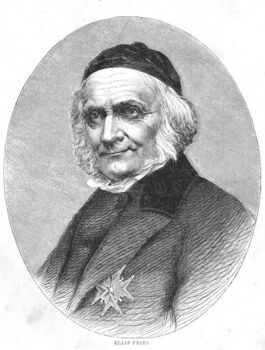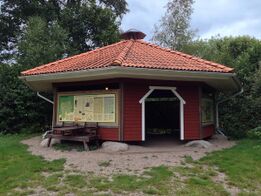Elias Magnus Fries
Topic: Biography
 From HandWiki - Reading time: 4 min
From HandWiki - Reading time: 4 min
Elias Magnus Fries | |
|---|---|
 | |
| Born | 15 August 1794 Femsjö, Hylte Municipality, Småland, Sweden |
| Died | 8 February 1878 (aged 83) Uppsala |
| Alma mater | Lund University |
| Known for | Founder of modern fungal taxonomy |
| Awards | Foreign Honorary Member of the American Academy of Arts and Sciences |
| Scientific career | |
| Fields | Mycology, Botany |
| Institutions | Lund University (1814–1834), Uppsala University (1834–1878) |
| Author abbrev. (botany) | Fr. |
Elias Magnus Fries FRS FRSE FLS (15 August 1794 – 8 February 1878) was a Swedish mycologist and botanist. He is sometimes called the "Linnaeus of Mycology".[1] In his works he described and assigned botanical names to hundreds of fungus and lichen species, many of which remain authoritative today.
Career
Fries was born at Femsjö (Hylte Municipality), Småland, the son of the pastor there.[2] He attended school in Växjö.
He acquired an extensive knowledge of flowering plants from his father.[3] In 1811 Fries entered Lund University[3] where he studied under Carl Adolph Agardh and Anders Jahan Retzius.[4] He obtained his doctorate in 1814. In the same year he was appointed an associate professorship in botany. He was elected a member of the Royal Swedish Academy of Sciences, and in 1824, became a full professor. In 1834 he became Borgström professor[3] (Swed. Borgströmianska professuren, a chair endowed by Erik Eriksson Borgström, 1708–1770) in applied economics at Uppsala University. The position was changed to "professor of botany and applied economics" in 1851. He was elected a Foreign Honorary Member of the American Academy of Arts and Sciences in 1849.[5] That year he was also appointed director of the Uppsala University Botanical Garden. In 1853, he became rector of the University.[6]
Fries most important works were the three-volume Systema mycologicum (1821–1832), Elenchus fungorum (1828), the two-volume Monographia hymenomycetum Sueciae (1857 and 1863) and Hymenomycetes Europaei (1874).[7]
Fries is considered to be, after Christian Hendrik Persoon, a founding father of the modern taxonomy of mushrooms. His taxonomy of mushrooms was influenced by Goethe and the German romantics. He utilized spore color and arrangement of the hymenophore (pores, gills, teeth etc.) as major taxonomic characteristics.[8][9] He was one of the most prolific authors of new fungal species, having formally described 3210 in his career.[10]
Fries died in Uppsala on 8 February 1878.[11] When he died, The Times commented: "His very numerous works, especially on fungi and lichens, give him a position as regards those groups of plants only comparable to that of Linnaeus."[12] Fries was succeeded in the Borgström professorship (from 1859 to 1876) by Johan Erhard Areschoug,[13] after whom Theodor Magnus Fries, the son of Elias, held the chair (from 1877 to 1899).[14]
Publications
- Monographia Pyrenomycetum Sueciae (1816)
- Systema Mycologicum (1821)
- Systema Orbis Vegetabilis (1825)
- Elenchus Fungorem (1828)
- Lichenographia Europaea Reformata (1831)
- Epicrisis Systematis Mycologici: seu synopsis hymenomycetum (1838)
Botanical Reference
Family
His wife was Christina Wieslander (1808-1862), with whom he raised nine children. His son Theodor Magnus Fries became a botanist and lichenologist, eventually holding the Borgström professorship himself, and another son, Oscar Robert Fries, became a physician in Gothenburg while maintaining a keen interest in mycology.[16] Theodor "Thore" Magnus's sons Thore Christian Elias Fries and Robert Elias Fries also became botanists.[17]
References
- ↑ Bevan, R.J. (1981). "Aspects of mycological history". Bulletin of the British Mycological Society 15: 20–25. doi:10.1016/S0007-1528(81)80003-X.
- ↑ "Fries, Elias Magnus" (in sv). Nordisk Familjebok. 8 (2 ed.). 1908. pp. 1393–1397. https://runeberg.org/nfbh/0751.html. Retrieved 3 September 2010.
- ↑ 3.0 3.1 3.2 Chisholm, Hugh, ed (1911). "Fries, Elias Magnus". Encyclopædia Britannica. 11 (11th ed.). Cambridge University Press. p. 229.
- ↑ "Elias Magnus Fries". Nature 17: 343. 1878. doi:10.1038/017343a0.
- ↑ "Book of Members, 1780–2010: Chapter F". American Academy of Arts and Sciences. http://www.amacad.org/publications/BookofMembers/ChapterF.pdf.
- ↑
 Rines, George Edwin, ed (1920). "Fries, Elias Magnus". Encyclopedia Americana.
Rines, George Edwin, ed (1920). "Fries, Elias Magnus". Encyclopedia Americana.
- ↑ Gulden, Gro; Eckblad, Finn-Egil (2007). "Elias Magnus Fries". in Henriksen, Petter (in no). Store norske leksikon. Oslo: Kunnskapsforlaget. http://www.snl.no/Elias_Magnus_Fries. Retrieved 27 March 2009.
- ↑ "Elias Magnus Fries (1794 - 1878) - a brief biography". https://www.first-nature.com/fungi/~biog-fries.php.
- ↑ "Elias Magnus Fries". Encyclopedia.com. 2018-05-18. https://www.encyclopedia.com/people/science-and-technology/botany-biographies/elias-magnus-fries.
- ↑ Lücking, Robert (2020). "Three challenges to contemporaneous taxonomy from a licheno-mycological perspective". Megataxa 1 (1): 78–103 [85]. doi:10.11646/megataxa.1.1.16.
- ↑ Biographical Index of Former Fellows of the Royal Society of Edinburgh 1783–2002. The Royal Society of Edinburgh. July 2006. ISBN 0-902-198-84-X. https://www.royalsoced.org.uk/cms/files/fellows/biographical_index/fells_indexp1.pdf. Retrieved 14 June 2016.
- ↑ The Times, Thursday, 21 February 1878; pg. 6; Issue 29184; col C
- ↑ Areschoug, John Erhard in Herman Hofberg, Frithiof Heurlin, Viktor Millqvist, Olof Rubenson, 1906, Svenskt biografiskt handlexikon, Albert Bonniers Förlag, Stockholm, pp 42-43. (In Swedish)
- ↑ Fries, Teodor (Thore) Magnus in Herman Hofberg, Frithiof Heurlin, Viktor Millqvist, Olof Rubenson, 1906, Svenskt biografiskt handlexikon, Albert Bonniers Förlag, Stockholm, pp 361-362. (In Swedish)
- ↑ IPNI, Fr., http://www.ipni.org/ipni/advAuthorSearch.do?find_abbreviation=Fr.
- ↑ Petersen, Ronald H.; Knudsen, Henning (2015). "The mycological legacy of Elias Magnus Fries". IMA Fungus 6: 99-114. doi:10.5598/imafungus.2015.06.01.04.
- ↑ Anders Backlund (2006-02-03). "The Fries Family of Botanists". Uppsala University. http://www.systbot.uu.se/information/history/fries.htm.
External links
- Error in Template:Internet Archive author: Elias Magnus Fries doesn't exist.
- "Elias Magnus Fries", Authors of fungal names, Mushroom, the Journal of Wild Mushrooming.
- Web site of the Descendants of Elias Fries Association
 "Fries, Elias Magnus". New International Encyclopedia. 1906.
"Fries, Elias Magnus". New International Encyclopedia. 1906.
| Cultural offices | ||
|---|---|---|
| Preceded by Erik Gustaf Geijer |
Swedish Academy, Seat No.14 1847–1878 |
Succeeded by Carl Rupert Nyblom |
 |
 KSF
KSF

